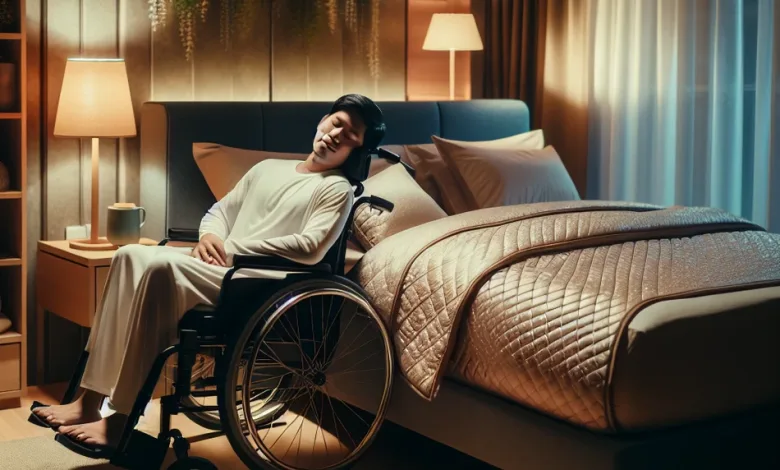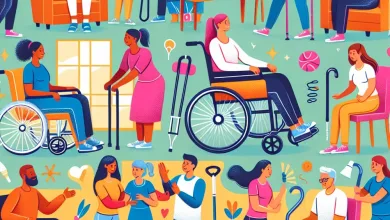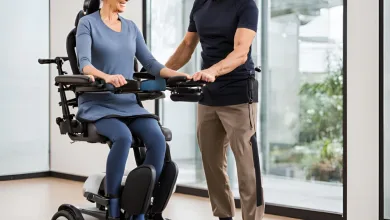Sleeping Strategies for Wheelchair Users: Sleep Better Tonight

Table of Contents
Restful Sleep Within Reach: A Guide for Wheelchair Users
Sleep Better Tonight: Sleeping Strategies for Wheelchair Users. Achieving quality sleep is vital for everyone, but wheelchair users often face unique challenges, such as pressure sores, pain, and difficulty finding comfortable positions. However, with some sleep hygiene adjustments and assistive technology, you can transform your bedroom into a proper sleep sanctuary.
This guide offers practical strategies to enhance sleep quality for wheelchair users, helping them wake up refreshed and rejuvenated.
Crafting an Accessible Sleep Environment
Turning your bedroom into an accessible sleep haven is crucial. Here’s how to create a more adaptive environment:
- Clear the Floor: Ensure ample space around the bed for easy wheelchair manoeuvrability. Remove unnecessary furniture and clutter.
- Bed Height: Choose a bed that facilitates comfortable transfers from your wheelchair. Ideally, the mattress should be slightly lower than your wheelchair seat.
- Transfer Ease: Install grab bars beside the bed and in the bathroom to assist with safe, independent transfers.
- Light Control: Use blackout curtains or an eye mask to block distracting light.
Pros and Cons of Adjustable Beds:
- Pros: Adjustable beds allow varied positioning throughout the night, potentially reducing pressure sores and enhancing comfort.
- Cons: These beds can be costly and unnecessary for everyone.
Tip: Consult an occupational therapist for personalized advice on creating an accessible sleep environment.
Developing a Relaxing Bedtime Routine for Wheelchair Users
A consistent bedtime routine benefits everyone, including wheelchair users. Here are some steps to help you wind down:
- Set a Sleep Schedule: Go to bed and wake up at the same time each day, even on weekends, to regulate your body’s natural sleep-wake cycle.
- Power Down Before Bed: Avoid screens (phones, laptops, TVs) for at least an hour before bedtime to prevent blue light from disrupting sleep.
- Relaxation Techniques: Take a warm bath, practice gentle stretches, or read a calming book to unwind.
- Light Dinner: Avoid heavy meals near bedtime, which can cause indigestion and disrupt sleep.
Remember, a relaxing bedtime routine is a personal journey. Experiment to find what works best for you.
The Power of Wheelchair Fitness and Sleep
Regular exercise can significantly enhance sleep quality. Here are some tips for integrating fitness into your routine:
- Low-Impact Exercises: To improve strength and flexibility without straining your body, engage in activities like hand cycling, swimming, or yoga.
- Time it Right: Aim for moderate exercise a few hours before bedtime to avoid feeling too energized close to sleep.
Important Note: Always consult your doctor before starting a new exercise program.
Fueling Your Body for Better Sleep: Nutrition for Wheelchair Users
What you eat can significantly impact your sleep quality. Here are some nutrition tips:
- Limit Caffeine and Alcohol: Both substances can disrupt your sleep cycle. Avoid caffeine in the afternoon and evening, and limit alcohol intake.
- Focus on Whole Foods: Prioritize a balanced diet of fruits, vegetables, and whole grains to provide essential nutrients for optimal sleep.
Dietitian Tip: Consulting with a registered dietitian can help you develop a personalized meal plan to support healthy sleep habits.
The Magic of Mindfulness for Sleep
Mindfulness practices can significantly improve sleep quality. Here’s how:
- Meditation: Spend a few minutes before bed meditating or practising deep breathing exercises to quiet your mind and promote relaxation.
- Visualization: Imagine a peaceful, calming place to direct your mind away from worries that might keep you awake.
Seeking Help from Sleep Specialists for Wheelchair Users
If sleep issues persist, consulting a sleep specialist can be beneficial. They can assess your situation, identify underlying causes, and recommend personalized treatment plans.
What to Expect:
- Detailed Evaluation: The specialist will discuss your sleep history, any pain, and current medications.
- Potential Tests: A sleep study might be recommended to monitor your brainwaves, breathing, and muscle activity.
- Treatment Options: To enhance sleep quality, recommendations may include lifestyle changes, specific sleep aids, or assistive technology.
Exploring Assistive Sleep Technology for Wheelchair Users
Technology offers various tools to improve sleep for wheelchair users:
- Pressure-Relieving Mattresses: These mattresses help reduce pressure sores and increase comfort.
- Memory Foam Wheelchair Cushions: Offering superior support and pressure relief, these cushions enhance comfort during both day and nighttime use.
- Smart Beds: Some beds adjust positions automatically to prevent pressure points and promote better posture.
- Sleep Tracking Devices: These devices monitor your sleep patterns and provide insights into your sleep quality.
Remember, while technology can supplement your sleep hygiene routine, it’s not a replacement for healthy sleep habits.
FAQs: Sleep Better Tonight: Strategies for Wheelchair Users
1. What do wheelchair users face as common sleep challenges?
Wheelchair users often encounter issues like pressure sores, chronic pain, difficulty finding comfortable sleeping positions, and challenges with transferring in and out of bed.
2. How can I make my bedroom more wheelchair-friendly for better sleep?
Clear floor space for easy wheelchair manoeuvrability, choose a bed height that facilitates easy transfers, install grab bars, and use blackout curtains or an eye mask to block light.
3. Are adjustable beds a good option for wheelchair users?
Adjustable beds can be beneficial as they allow for changing positions throughout the night, reducing pressure sores and improving comfort. However, they can be expensive and may only be necessary for some.
4. What bedtime routine tips can help wheelchair users sleep better?
Establish a consistent sleep schedule, avoid screens before bed, practice relaxation techniques like stretching or reading, and avoid heavy meals close to bedtime.
5. How does regular exercise impact sleep for wheelchair users?
Regular, low-impact exercises such as hand cycling, swimming, or yoga can improve sleep quality by enhancing strength and flexibility and reducing stress.
6. What dietary habits can improve sleep for wheelchair users?
Limiting caffeine and alcohol and focusing on a balanced diet of fruits, vegetables, and whole grains can improve sleep quality.
7. How can mindfulness practises aid sleep for wheelchair users?
Practices like meditation and visualisation can help quiet the mind, reduce stress, and promote relaxation, making it easier to fall asleep and stay asleep.
8. When should a wheelchair user consider seeing a sleep specialist?
If you experience persistent sleep issues despite trying various strategies, consulting a sleep specialist who can provide personalised treatment plans and solutions may be helpful.
9. What assistive sleep technologies are available for wheelchair users?
Options include pressure-relieving mattresses, smart beds that adjust positions automatically, and sleep-tracking devices that monitor sleep patterns and provide insights.
10. Can sleep aids be safely used by wheelchair users?
It’s essential to consult with a healthcare provider before using any sleep aids, as they may interact with other medications or have side effects that could affect your health.
Remember, consistency is key! By implementing these practical strategies and prioritizing healthy sleep habits, you can achieve restful sleep and wake up refreshed and ready to tackle the day.
We hope you found the tips and strategies helpful in enhancing your sleep quality and creating a restful sleep environment. We value your thoughts and experiences, so please share them in the comments section below. Don’t hesitate to contribute to the conversation if you have any questions or additional tips that have worked for you. Your insights could be invaluable to others in our community.
Sweet dreams!



